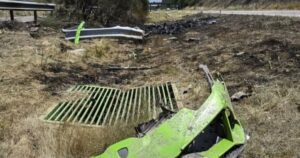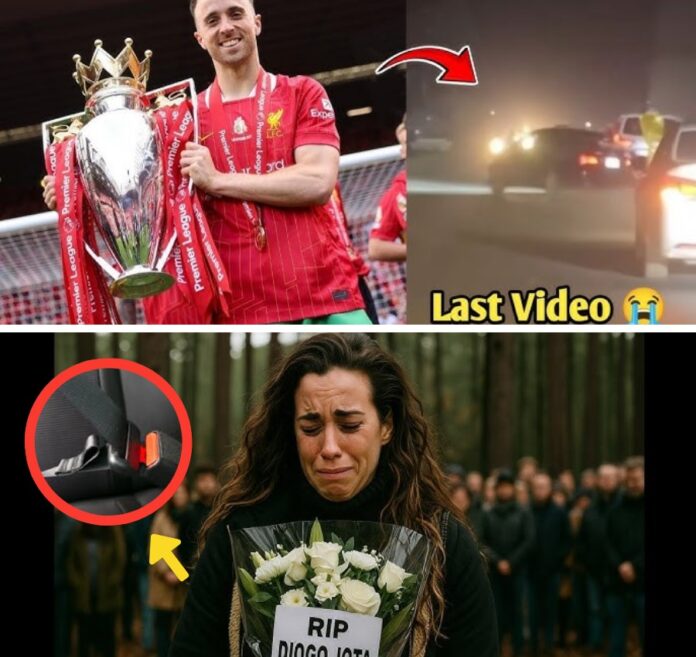Shocking Turn in Diogo Jota’s Crash: Mysterious Crescent-Shaped Burn Marks Raise Questions
On July 3, 2025, the football world was rocked by the tragic deaths of Liverpool and Portugal star Diogo Jota and his brother André Silva in a car crash in northwestern Spain. The accident, which occurred on the A-52 motorway near Zamora, claimed the lives of the 28-year-old forward and his 25-year-old brother when their Lamborghini Huracan veered off the road, reportedly due to a tire blowout, and burst into flames. As the investigation into the crash deepens, a startling revelation has emerged: investigators have discovered 17 crescent-shaped burn marks beneath Jota’s seatbelt, which his widow, Rute Cardoso, claims match a childhood scar on his back. This development has sparked intrigue, speculation, and renewed scrutiny into the circumstances surrounding the tragedy.
The Tragic Accident

Diogo Jota, a beloved figure in football, was driving with his brother André Silva toward Santander, Spain, to catch a ferry back to England for Liverpool’s pre-season training. The journey followed Jota’s recent wedding to his childhood sweetheart, Rute Cardoso, on June 22, 2025, a joyous occasion celebrated just 11 days before the crash. According to initial reports from Spain’s Guardia Civil, the Lamborghini suffered a tire blowout while overtaking another vehicle, causing it to skid off the A-52 motorway and ignite. The intensity of the fire nearly destroyed the vehicle, complicating early investigative efforts. Both brothers perished at the scene, leaving behind a grieving family, including Jota’s wife and their three young children, Denis, Duarte, and a daughter born in 2024.
Preliminary findings suggested that Jota was likely speeding, with tire marks indicating the vehicle exceeded the 120 km/h (75 mph) speed limit. The Guardia Civil’s traffic division noted that the car’s skid marks, stretching approximately 100 meters from the point of impact, pointed to excessive speed as a contributing factor. However, the discovery of unusual burn marks has shifted the focus of the investigation, raising questions about whether other factors may have played a role in the tragedy.
The Mysterious Burn Marks

The most shocking development in the investigation came when forensic experts uncovered 17 crescent-shaped burn marks beneath the seatbelt on the driver’s side, presumed to be Jota’s position. These marks, described as uniform and precisely shaped, were found on the fabric of the seatbelt and the surrounding area. Unlike typical burn patterns associated with a car fire, these marks stood out due to their distinct crescent shape and consistent placement. According to sources close to the investigation, the marks appeared deliberate, almost as if they were imprinted rather than caused by random fire damage.
Rute Cardoso, Jota’s widow, provided a chilling personal connection to these findings. She revealed to investigators that Jota had a distinctive crescent-shaped scar on his back from a childhood accident. According to Cardoso, the scar resulted from an incident during Jota’s youth in Porto, where he fell against a hot metal object, leaving a permanent mark. Cardoso claims the burn marks found under the seatbelt bear an uncanny resemblance to this scar, both in shape and size. She expressed her belief that the marks could hold a deeper significance, though she stopped short of speculating publicly about their origin.
The revelation has prompted investigators to explore several theories. One possibility is that the marks were caused by a malfunction or anomaly in the seatbelt mechanism, potentially exacerbated by the fire’s intensity. Another theory, though less conventional, considers whether an external factor—such as a chemical agent or a design flaw in the vehicle—could have produced such precise patterns. The Guardia Civil has stated that the expert report is still being finalized and will be submitted to the Puebla de Sanabria court for further review. Until then, the cause of the burn marks remains an open question.
Rute Cardoso’s Grief and Determination
Rute Cardoso, who met Jota in high school and supported him throughout his rise from Paços de Ferreira to global stardom, has been thrust into the spotlight amid her grief. The couple’s love story, rooted in their shared Porto origins, was a source of inspiration for fans. Cardoso, described as a private yet fiercely supportive partner, relocated with Jota to Wolverhampton and later Liverpool, raising their three children while he pursued his career. Her emotional collapse outside the morgue after identifying Jota’s body underscored the profound loss she has endured.
Cardoso’s claim about the burn marks matching Jota’s childhood scar has added a personal dimension to the investigation. In a statement shared through a family representative, she urged authorities to thoroughly examine the marks, stating, “Diogo’s scar was a part of who he was, a mark from his childhood that he carried with pride. If these burns are connected to it, I want to know why and how.” Her determination to seek answers has resonated with fans and the football community, many of whom have rallied around her on social media, offering condolences and support.
Theories and Speculation

The discovery of the crescent-shaped burn marks has fueled widespread speculation, both in the media and among fans. Some have questioned whether the marks could indicate foul play, though no evidence currently supports this theory. The Guardia Civil has emphasized that the crash appears to have been a tragic accident, with no other vehicles involved and no signs of external interference. However, the unusual nature of the burn marks has led to online discussions about potential defects in the Lamborghini Huracan or its safety systems.
Automotive experts have noted that seatbelt burns are rare in crash-related fires, as the materials are designed to withstand high temperatures. The crescent shape, in particular, is difficult to explain through standard fire dynamics. One hypothesis being explored is whether a chemical reaction or a manufacturing defect in the seatbelt or car interior could have caused the marks. Another possibility is that an object Jota was carrying, perhaps related to his childhood scar, left imprints during the fire. These theories remain speculative, as forensic analysis is ongoing.
The football community, meanwhile, has focused on honoring Jota’s legacy while grappling with the tragedy’s unanswered questions. Tributes from teammates, including Cristiano Ronaldo and Virgil van Dijk, have highlighted Jota’s humility and warmth. Former Liverpool manager Jürgen Klopp described him as “a fantastic player and a great friend,” while current manager Arne Slot vowed to celebrate Jota’s contributions when the time is right. The presence of Liverpool players at the brothers’ funeral in Gondomar underscored the profound impact of their loss.
The Investigation Continues
As the Guardia Civil prepares its final report, the focus remains on determining the precise cause of the crash and the origin of the burn marks. The investigation has been complicated by the fire’s intensity, which destroyed much of the vehicle and physical evidence. Forensic teams are analyzing the seatbelt material, tire fragments, and skid marks to piece together the sequence of events. The crescent-shaped marks, while intriguing, may ultimately prove to be a secondary detail, but their connection to Jota’s childhood scar has captured public attention.
For Rute Cardoso and her family, the search for answers is deeply personal. The loss of Jota and André Silva has left a void in the football world and in their hometown of Gondomar, where fans and friends continue to mourn. Cardoso’s insistence on understanding the significance of the burn marks reflects her commitment to honoring her husband’s memory. As she navigates her grief, she remains a symbol of resilience, determined to uncover the truth behind the tragedy that took her husband and brother-in-law.
A Legacy Beyond the Pitch
Diogo Jota’s death has reverberated far beyond football, touching fans, political leaders, and even royalty, with tributes from figures like Prince William and UK Prime Minister Sir Keir Starmer. His journey from Porto’s suburbs to Liverpool’s Premier League triumph inspired countless young athletes. The mystery of the crescent-shaped burn marks adds a haunting layer to his story, but it does not diminish his legacy as a player, husband, father, and friend. As the investigation unfolds, the football world holds its breath, hoping for clarity in a tragedy that feels all too senseless.



